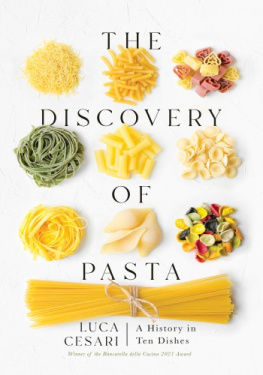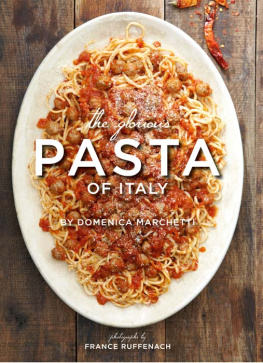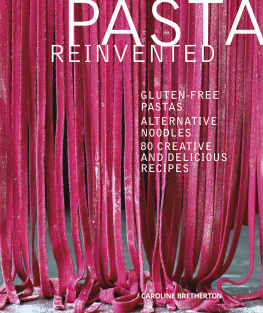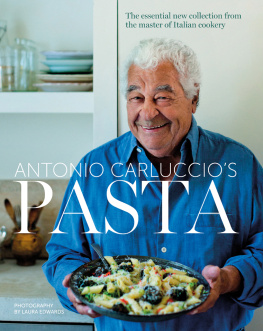INTRODUCTION
A nyone who cooks up a dish of pasta, anywhere in the world, cant help thinking of Italian cuisine. Even if they live on another continent and the food has been in their diet for generations, it makes no difference: the Bel Paese is a touchstone by default.
Yet pasta does not just belong to Italy: in the Western world alone, theres Moroccan couscous, Spanish fideu (a paella made with short, thin noodles instead of rice), and all kinds of filled pasta German maultaschen, Russian pelmeni, Ukrainian varenyky, the uszka and pierogi of Eastern Europe and so on which have nothing to do with the Italian tradition and developed on their own.
If you think about it, its a little strange that a single country in the heart of the Mediterranean developed a culture with hundreds of pasta dishes, up and down the peninsula, that characterise its cuisine more than anything else. In the end, pasta is just one way of eating a dough of water and flour: bake it, and its a pie, flatbread or pizza; dip it in boiling oil, and its a fritter (plain or filled), but boil it in water, and youve entered the vast world of pasta.
Definitions are not set in stone, however, and that is why, for the first few centuries of its existence, pasta was not considered a culinary category unto itself (see, for instance, the chapter on lasagne). The circumstances of its birth are also rather hazy, and although we know that Sicily was a centre of production for dried pasta as early as the twelfth century, the thread of its origins gets lost somewhere back in Classical Greece and the Near East.
Seen from the outside, Italy is one nation united under pasta: families cook it almost every day at home, and very few restaurants fail to offer at least one kind on the menu. There are famous recipes that can be found everywhere and have become true national symbols, like spaghetti with tomato sauce, but most have an extremely local connotation. You can probably find a good carbonara in Milan, or excellent trenette with pesto in Rome, but these dishes are still closely associated with the place where they were invented. If we look a little closer, we will notice that every place has its own speciality, and that the next town over has a different way of cooking what is more or less the same dish. Italian cuisine is built from a myriad of recipes forming an intricate mosaic, whose tiles arent easy to make out; the differences are sometimes minimal, and may even hinge on individual family traditions.
Its a bit like looking at an Impressionist painting: seen from afar, it seems clear enough, but as you get closer the overall picture splits apart and the brushstrokes become an indistinguishable blur.
Since pasta is a food so deeply tied to identity, it becomes a factor distinguishing those who cook it, or rather know how to cook it, from those who dont; in short, the classic dividing line of Us and Them, which more or less falls along national boundaries. When Italians go abroad, they cant help being amazed by how pasta is eaten in other countries, and two common errors in particular draw the fiercest criticism. The first is cooking it too long, that is, not al dente: that characteristic consistency where the core is still firm to the bite. A dish of spaghetti or macaroni that is too soft is thought of as a mortal sin, and in Italy would justify sending the food back to the kitchen, although that rarely happens.
The other mistake that They often make is serving pasta as a side to meat. Those noodles nestled alongside a bit of roast, or maybe a beef stew? To an Italian, theyre completely incomprehensible, because pasta is a primo piatto , a first course, and meat is a secondo , and never the twain shall meet.
What many fierce Italian champions of orthodoxy do not realise is that these two ways of serving pasta were once quite common even back home, and it was from here that they spread abroad over a century ago. Overcooked pasta youll find various examples in the last chapter was standard in northern Italy until the early twentieth century; the fashion of cooking it al dente sprang up in the South, and took a long time to work its way up the peninsula and become the national standard. Just a few generations ago, it was normal for a Neapolitan to cook pasta differently compared to someone in Milan.
The habit of using it as a side dish was also quite common. From the Renaissance up to the late nineteenth century, one finds many cookbooks that suggest covering boiled meat, especially poultry such as duck or capon, with macaroni or filled pasta. In Italy, this custom almost completely disappeared over the course of the twentieth century, as pasta carved out its own place on the menu, both at home and in public settings.
Essentially, when Italians criticise this sort of thing, they are revealing the cultural divide that separates them not only from foreigners, but from their own ancient culinary roots.
In countries such as Germany, Britain, France or the United States, pasta was brought by Italian immigrants. Initially considered an interloper at the national table, it took quite a while to be assimilated into those cuisines. And as we know, immigrant communities tend to be protective of their traditions, which they rightfully consider a fundamental part of their identity. So this along with the fact that contact with their homeland was only sporadic may be why their cooking preserved some older habits, continuing down a path that Italy diverged from. In much the same way that a language cut off from its country of origin tends to evolve separately, holding on to some archaic patterns of speech.
This led to hybridised cuisines that have every right to exist, but almost never reflect contemporary Italian usage. For instance, Italian American cooking, with its spaghetti and meatballs, chicken Alfredo or macaroni and cheese: recipes that all evolved out of traditional Italian ones, but are now only distantly related to those original delicacies and have no real counterpart in Italy. The famous macaroni dish so common in the US and UK actually echoes the oldest way of eating pasta topped with cheese alone but remains a speciality of the English-speaking world, and youd never find it on a restaurant menu in my country.
Pasta becomes entangled with cultural identity not just in relation to foreigners, but even and one might say above all when Italians are talking to other Italians. Endless arguments over the authentic recipe for a given speciality are par for the course. This maniacal attachment to our foods usually causes considerable amusement among non-Italians, who cant see why, say, the very notion of breaking spaghetti in half to fit it in the pot, or of adding a spoonful of tomato sauce to carbonara, should be such hot-button issues.
In Italy, there have always been foods associated with a given region, and examples can be found all the way back to the Middle Ages, although they are often individual products rather than actual dishes.
Even in those days certain foods had a special relationship with their place of origin, but there was nothing resembling the fanatical attachment to tradition that we see today. The fierce battle against real or imagined threats to our national cuisine is a rather recent phenomenon. And the particularly inflexible attitude of the people I call food purists in this book took shape around the beginning of the 1960s, during Italys frenzied industrialisation. If you read the newspapers of the time, they convey a clear sense that Italian culinary traditions were in jeopardy: according to commentators, an incredible legacy was at risk of disappearing for good.
The model they were looking to was France, which had been keenly aware of its national culinary heritage for some time and was working to protect certain skills, terroirs, and products through research and publications.
Next page






